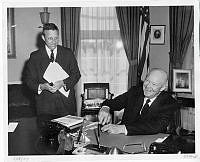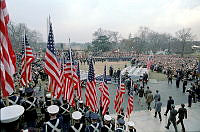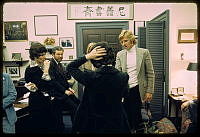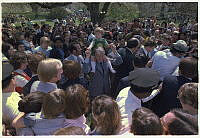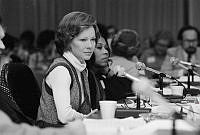The Eisenhower Family Home, in Abilene, Kansas
Originally Printed in President Eisenhower’s White House: White House History Number 21
Copyright © 2007 White House Historical Association. All rights reserved under international copyright conventions. No part of this article may be reproduced or utilized in any form or by any means, electronic or mechanical, including photocopying, recording, or by any information storage and retrieval system, without permission in writing from the publisher. Requests for reprint permissions should be addressed to books@whha.org

Brothers Arthur, Dwight, and Milton Eisenhower in front of the family home, 1947, where they were reared with their brothers Edgar, Roy, and Earl.
Dwight D. Eisenhower Presidential Library, Museum & Boyhood Home/NARAThe Eisenhower Family Home is located in the heart of the Midwest—Abilene, Kansas—and is part of the complex known as the Eisenhower Center. The 23 acre center includes the Dwight D. Eisenhower Presidential Library, a repository for the papers of the thirty-fourth president of the United States; the Eisenhower Museum; the Visitors Center; and the Place of Meditation, where Dwight David Eisenhower and Mamie Doud Eisenhower are buried. Also buried here is their first-born son, Doud Dwight, affectionately nicknamed lcky by his maternal grandmother; the child died at the age of three in 1921, more than thirty years before the start of the presidency and originally had been buried in Denver. The Eisenhower Center is administered by the National Archives and Records Administration (NARA) and is one of twelve libraries in the Presidential Library system. The Eisenhower Family Home is the only historic home in the NARA system. Many of the presidential homes and birthplaces are operated by the National Park Service or a state agency.
Much has been written about the history of the town of Abilene, Kansas. It is known from 1867 to 1885 for its cattle trail days as “The End of the Chisholm Trail”; a Wild West town that had a famous U.S. marshal, Wild Bill Hickok; a community of fine Victorian homes; and Eisenhower’s boyhood home. In fact, on I-70, as one approaches Abilene from the east or the west, billboards advertise Abilene as the town of “History, Mansions, and Heroes.”

A view of the downtown area of Abilene, Kansas, in 1905, when Dwight Eisenhower was about 10 years old. The town's rowdy reputation, gained in the days of Wyatt Earp and Bat Masterson was gone and the Eisenhowers were part of a peaceful fanning and mercantile community.
Dwight D. Eisenhower Presidential Library, Museum, & Boyhood Home/NARAA large part of the history of the Eisenhower Family Home was collected by J. Earl Endacott, a retired schoolteacher and the executive secretary of the Eisenhower Foundation and curator of the Eisenhower Home and Museum, which was operated privately by the foundation. In the early 1970s, Charlotte Clark, education specialist, and I assisted Endacott in developing a more comprehensive history of the house and the grounds for use as a training guide for the docents in the Eisenhower Family Home. In the mid-1970s the museum staff began an archaeological dig of the grounds to locate several outbuildings that had been removed in the 1930s.
The Eisenhower family migrated to Dickinson, Kansas, from Lancaster, Pennsylvania, in 1878. Three generations of the Eisenhower family made the trip; they were in the first group to come to this community. Frederick Eisenhower (the president’s great-grandfather), the senior member, was accompanied by his son Jacob Frederick and several of Jacob Frederick’s children, including David, Ike’s father. They settled in a community southeast of Abilene known as Belle Springs. Another group came to this area a year later. This migration was part of a close-knit religious group known as the River Brethren that was devoted to its religious beliefs and also to the economics of the community. Eventually these newcomers formed the Belle Springs Creamery, an outlet for selling dairy products from their farms to consumers. In later years, Eisenhower’s father worked at the creamery along with all of his sons while they were in high school.
The Eisenhower Family Home, according to records found in the Dickinson County Courthouse, was erected on lot 9, block 8, of the J. M. Fisher Addition, Dickinson County, Abilene, Kansas. This original structure at 201 Southeast Fourth Street was built by Ephraim Ellis, a schoolteacher, in 1887. The property returned to the ownership of J. M. Fisher for nonpayment of property taxes. On May 11, 1894, Anna B. Eisenhower, wife of Abraham Lincoln Eisenhower, Dwight’s uncle and a lay preacher, purchased the house from the estate of J. M. Fisher for $200. In 1898, Abraham entered the ministry on a full-time basis in Oklahoma; he and his wife, Anna, sold the home to Ida Stover Eisenhower, Dwight’s mother, for $1,000, as recorded in the Dickinson County Courthouse, Office of the Register of Deeds, on November 4, 1898. On August 24, 1907, the deed was changed to reflect joint ownership of both Eisenhower’s parents, David J. Eisenhower and Ida S. Eisenhower.

The Eisenhower boys at the 112 Southeast Second Street residence, where the family lived from 1892 to 1898, a small one-story house, their first Abilene home.
Dwight D. Eisenhower Presidential Library, Museum & Boyhood Home/NARAThe location proved ideal for the fast-growing family of Eisenhower boys. Ida and David, married in 1885, had seven sons: Arthur Bradford (1886-1958), Edgar Newton (1889-1971), Dwight David (1890-1969), Roy Jacob (1892-1942), Paul Abraham (1894-1895), Earl David (1898-1968), and Milton Stover (1899-1985) Along with the residence, the nearly three acres of land contained a vegetable garden planted by the Eisenhowers. Lincoln Grade School was located on the west, across the street, and several somewhat similar residences stood on the south.

The Eisenhower home as the Eisenhowers bought it prior to the south porch addition. Parlor windows look onto an uncovered deck or terrace.
Dwight D. Eisenhower Presidential Library, Museum & Boyhood Home/NARAIn architectural terms, the Eisenhowers’ house would have been called a “cottage” for sure. The style was probably the "chalet" mode, or perhaps Queen Anne. The cubical two-story form was made interesting by an asymmetrical arrangement of a small entrance porch and an uncovered deck railed in wooden fretwork. Odd peaked pediments surmounted the pair of windows of the parlor, which was also enhanced by a bay window. It was a charming cottage with a decorative flair. Sometime after 1900, the Eisenhower family added a new one-story south porch, the entire width of the house. Three round Doric columns supported the flat roof, which was crowned by a wooden balustrade. With this change the Victorian cottage took on the look of a more modern Colonial Revival house.
The structure was wood balloon frame, two stories, painted white, with three very small rooms on each floor. On the first were the front and back parlors, divided by a long, narrow entry hall and stairwell that terminated in a combined dining room-kitchen. The hallway was also used as a room for sewing and storage for quite a number of books. Upstairs were two bedrooms plus a small bedroom known for a while as the nursery but later always the bedroom for the oldest boy living at home. The house was constructed of white pine clapboard siding with a cedar shingle roof. The interior walls were lath and plaster trimmed with pine woodwork that was variously stained or painted. The original piers and footings were stones held together by mortar. Dug out beneath the house was a storm and root cellar with dirt walls and floor, but the rest of the area was a crawl space.

The Eisenhower Family Home, c. 1900, with the added south porch and crowning balustrade crossing the front, providing shade and a comfortable living room.
Dwight D. Eisenhower Presidential Library, Museum & Boyhood Home/NARAPrior to the move in 1898, the Eisenhowers had lived at 112 Southeast Second Street, a block and a half north of the structure today known as the Eisenhower Family Home. Ike later recalled:
The move from the little cottage on Second to the new house was a step up in the world! A large ones was occupied by Father and Mother with the baby, Earl, in a cradle. Three boys slept in the adjoining room, Roy and I in one bed, Edgar in the other. Arthur, the eldest, was awarded the little room at the end of the hall. Its dimensions were 6 1/2 feet by 6 1/2 feet. Whether considered as an underdeveloped bedroom or a generous closet, the rest of us envied his splendid isolation. He was the only person in the house with a room of his own. 1
After a visit to Abilene in 1962, Edgar wrote to Ike, “Earl, Milton and I visited the home and again I was struck by the smallness of the rooms and I wondered how eight people could ever have lived in such small quarters. In fact, we three brothers were unable to determine exactly where Earl and Milton slept.”2 But Eisenhower also recalled his mother’s delight in the new house: “For the first time we have a home where my children will have room to play. I am most thankful.”3
In 1900, the living space was increased by the addition of two bedrooms and a small connecting closet to the east side of the house. This addition provided space for Grandfather Jacob Frederick Eisenhower, who moved in with his son after the death of his wife, Rebecca, and later the death of his housekeeper-caregiver. The bedroom Grandfather Eisenhower occupied was also the room in which young Dwight passed through one of the most difficult episodes of his early years. Stricken with blood poisoning at age 16, Dwight refused to allow the doctor to amputate his badly infected leg. Two of his brothers guarded the door, which the patient had barricaded from within. A local physician later consulted a Topeka physician, and with the drastic treatment, “the painting of a belt of carbolic acid around my body, the progress of the disease was stopped, ” 4 Eisenhower later recalled. Recovery was complete, but young Dwight lost so much time from school that he was forced to repeat his freshman year of high school. A few years after Grandfather Eisenhower’s death in 1906, when city water and sewer connections arrived in the south side of Abilene, this bedroom was converted into a bathroom.
In 1915 a new kitchen and pantry were built on the north end of the house. Prior to this addition, the cooking took place in the largest room of the house, the combined dining room and kitchen on the back of the first floor. A large coal-burning stove was located in this room until 1919, when gas was finally brought into the area and the kitchen was moved into the 1915 kitchen space.
In 1911, Eisenhower left his family and Abilene for the United States Military Academy, West Point, New York. Upon graduation in 1915 as a second lieutenant, he was assigned to Fort Sam Houston in San Antonio, Texas. There in the fall of 1915, he met Mamie Geneva Doud, and, after a brief courtship, they became engaged on Valentine’s Day, 1916. They originally planned a November wedding, but with war raging in Europe, the young couple decided to marry on July 1, 1916, in Denver. No Eisenhower relations were present at the wedding. Therefore, after a brief honeymoon the newlyweds left Denver by train for Abilene to see Ike’s family for a matter of hours before heading back to San Antonio. They arrived very early in the morning. “My Mother was determined that we would have at least one fine meal in her house,” Eisenhower recalled, “and so instead of the normal breakfast, our meal that morning was a monumental fried chicken dinner. "5

Dwight Eisenhower and Mamie Eisenhower on their wedding day, Denver, Colorado, July 1, 1916.
Dwight D. Eisenhower Presidential Library, Museum & Boyhood Home/NARAThe bride’s memories of the Eisenhower family home, on the few visits she made, were not always pleasant. She later explained that soon after she and her husband arrived in Abilene for family visits, Ike would leave and go into town and play cards with his male friends, leaving her at the house with her in-laws. Ida and David Eisenhower were stern River Brethren who did not condone smoking, much less drinking, in their house. Mamie would slip upstairs, sit by an open bedroom window, and have her cigarette, blowing the smoke through the window screens.6
The Eisenhower boys grew to manhood in this simple house and nurturing home. Their success in life is remarkable. Arthur, a banker, lived in Kansas City; Edgar, a lawyer, lived in Tacoma, Washington; Dwight was supreme commander, Allied Expeditionary Forces, during World War II, president of Columbia University, and thirty-fourth president of the United States; Roy, a pharmacist, lived in Junction City, Kansas; Earl, an electrical engineer, lived in Illinois and Indiana; and Milton was president of Kansas State University, Pennsylvania State University, and Johns Hopkins University, and was an indispensable special adviser to the Eisenhower administration. The boys’ father died in 1941, and Ida Eisenhower continued to live in the house with the assistance of a caregiver until her death in 1946. The Eisenhower sons donated the property to the newly created Eisenhower Foundation with the understanding that the furnishings must remain as left by their mother and no major changes could be made to the home without their consent. The foundation opened the Eisenhower Home to the public on June 22, 1947, and since that time it has been seen by more than 3 million visitors.

First Lieutenant Dwight D. Eisenhower (seated on the steps) with his family on the south porch in 1926. From Left to Right: his brothers Roy, Arthur, Earl, and Edgar, his father David, his brother Milton, and his mother Ida

President Dwight D. Eisenhower's parents, Ida and David Eisenhower, on their south porch, about the beginning of World War II.
Dwight D. Eisenhower Presidential Library, Museum & Boyhood Home/NARAIn July 1951 Smoky Hill River, just south of Abilene, and Mud Creek, to the west, rose to flood stage and crested 3 feet higher than the record set in a 1903 flood. Floodwaters did not damage the first floor of the Eisenhower Home, but the basement was engulfed in water and its rock foundation was ruined. Because of cost, temporary measures only were undertaken. In 1955, however, Edward J. and Katherine Bermingham, friends of Eisenhower from his days as president of Columbia University, were visiting from Wyoming and worked out an agreement to assist financially with the needed repairs. A contracting firm prepared a full condition report of the structure and outlined the work needed to stabilize it and to improve the grade above the floodplain. Following completion of repairs, the home was rededicated on November 27, 1956. Routine maintenance, replacement of climate and security systems, the replication of the first floor interior wall coverings, and occasional exterior painting and reroofing have ensured that it looks the same now as it did then.
In a January 12, 1962, letter to his brothers, Eisenhower described a proposal from Harry Darby, chairman of the Eisenhower Foundation, that the home be turned over to the federal government.7 This transaction was not completed until 1966, when the Eisenhower Foundation turned over ownership of the home and the Eisenhower Museum buildings to the federal government to operate them as part of the Presidential Library system. The governing agency was originally the General Services Administration. In 1985, Congress created an independent agency within the federal government, the National Archives and Records Administration, and within this administration the Office of Presidential Libraries.

The widowed Ida Eisenhower with Eisenhower Foundation members on the west side porch, 1945. After her death, her sons donated the house to the foundation, specifying that it be kept exactly as she left it.
Dwight D. Eisenhower Presidential Library, Museum & Boyhood Home/NARA
Merrill Eisenhower Atwater, the president’s great-grandson, speaks from the front porch of the Eisenhower Family Home at a program marking the fiftieth anniversary of President Dwight Eisenhower's great project, the National Defense Highway Act that created the interstate highway system.
Dwight D. Eisenhower Presidential Library, Museum & Boyhood Home/NARA
A recent aerial view of the Dwight D. Eisenhower Presidential Library and Museum.
Dwight D. Eisenhower Presidential Library, Museum & Boyhood Home/NARAOn January 25, 1971, State Historic Preservation Officer Nyle Miller signed the documents placing the Eisenhower Family Home on the National Register of Historic Places. The home has been the site of several Eisenhower-Doud family reunions, and most recently Merrill Eisenhower Atwater, great-grandson of the president, gave remarks on the porch of the home for the fiftieth anniversary of President Eisenhower’s signing of the National Defense Highway Act creating the interstate highway system.
He said, Abilene holds a special place in our family’s heart. This is where our roots are. My great-grandfather lived right here where I am standing. It is amazing to me and eerie at the same time knowing that he played right where I am standing. . . . That is absolutely fantastic.8














